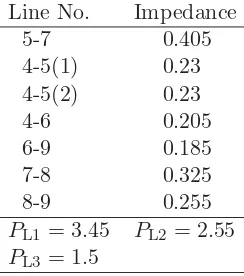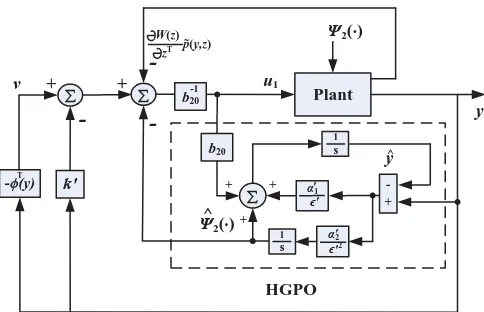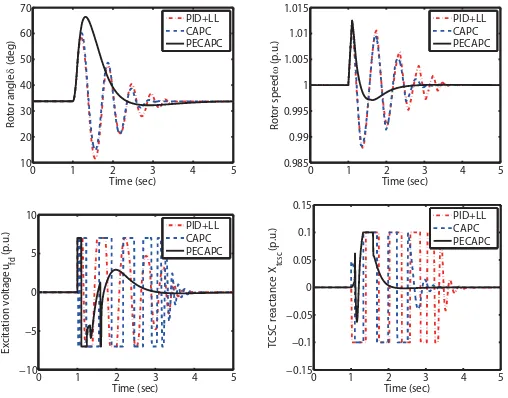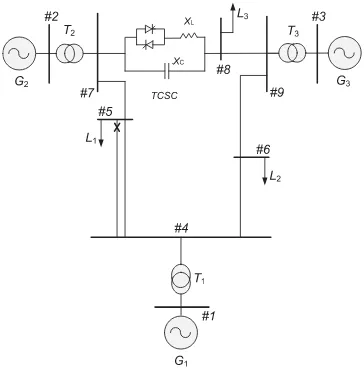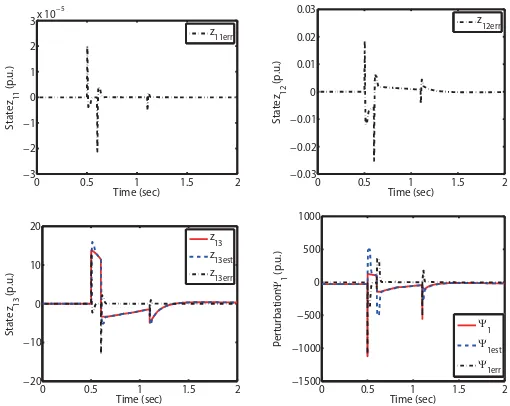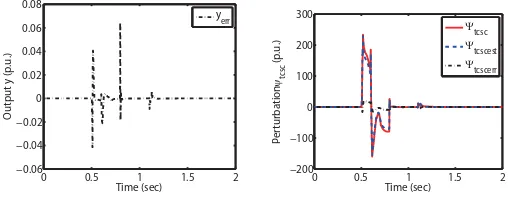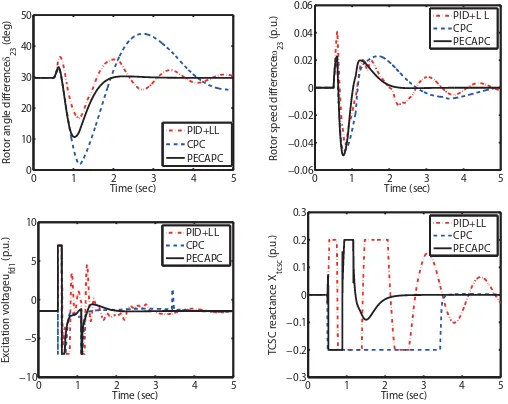Perturbation Estimation Based Coordinated Adaptive
Passive Control for Multimachine Power Systems
B. Yanga, L. Jianga, Wei Yaob,a, Q. H. Wuc,a,∗
aDepartment of Electrical Engineering and Electronics, University of Liverpool,
Liverpool, L69 3GJ, United Kingdom
bState Key Laboratory of Advanced Electromagnetic Engineering and Technology,
Huazhong University of Science and Technology, Wuhan, 430074, China
cSchool of Electric Power Engineering, South China University of Technology,
Guangzhou, 510641, China
Abstract
This paper proposes a perturbation estimation based coordinated adaptive
passive control (PECAPC) of generators excitation system and
thyristor-controlled series compensator (TCSC) devices for complex, uncertain and
interconnected multimachine power systems. Discussion begins with the
PECAPC design, in which the combinatorial effect of system
uncertain-ties, unmodelled dynamics and external disturbances is aggregated into a
perturbation term, and estimated online by a perturbation observer (PO).
PECAPC aims to achieve a coordinated adaptive control between the
exci-tation controller (EC) and TCSC controller based on the nonlinearly
func-∗Corresponding author
tional estimate of the perturbation. In this control scheme an explicit control
Lyapunov function (CLF) and the strict assumption of linearly parametric
uncertainties made on power system structures can be avoided. A
decen-tralized stabilizing EC for each generator is firstly designed. Then a TCSC
controller is developed to passivize the whole system, which improves
sys-tem damping through reshaping the distributed energies in power syssys-tems.
Case studies are carried out on a single machine infinite bus (SMIB) and a
three-machine power system, respectively. Simulation results show that the
PECAPC-based EC and TCSC controller can coordinate each other to
im-prove the power system stability, finally a hardware-in-the-loop (HIL) test is
carried out to verify its implementation feasibility.
Keywords: Coordinated adaptive passive control, perturbation estimation,
energy shaping, multimachine power systems.
1. Introduction
Power system stability is becoming a crucial issue as the size and
com-plexity of power systems increase [1]. Conventional linear control methods
have been widely used, however, they cannot maintain consistent control
performance as power systems are highly nonlinear, which operate under a
generator excitation control is one of the most popular methods to enhance
the power system stability. Many nonlinear control approaches have been
used for the excitation controller (EC), such as adaptive H∞ control [3], L-2
disturbance attenuation control [4], nonlinear adaptive control [5], adaptive
dynamic programming [6], and optimal predictive control [7]. On the other
hand, proper controllers of flexible AC transmission systems (FACTS) can
also improve the power system stability. Many studies have been undertaken
on the development of nonlinear controllers for thyristor controlled series
compensation (TCSC) [8], static variable compensator (SVC) [9], and static
synchronous compensator (STATCOM) [10]. However, uncoordinated EC
and FACTS controller may deteriorate each other or even lead to instability
under large disturbances [1].
To resolve the above issues, many nonlinear coordinated control approaches
of excitation systems and FACTS devices have been applied to achieve an
op-timal performance of the whole system, such as opop-timal-variable-aim
strate-gies [11], global control [12], and zero dynamics method [13]. However,
these methods require accurate system models in the controller design
pro-cess, which are difficult to guarantee their reliable performances when
coordinated control methods are investigated in [14, 15, 16]. However, their
design is complicated and cancels possible beneficial nonlinearities. Besides,
the optimal control performance may not be obtained as the physical
prop-erty of a power system is ignored.
Passivity provides a physical insight for the analysis and design of
non-linear systems, which decomposes a complex nonnon-linear system into simpler
subsystems that, upon interconnection, and adds up their local energies to
determine the full system’s behavior. The action of a controller connected to
the dynamical system may also be regarded, in terms of energy, as another
separate dynamical system. Thus the control problem can then be treated as
finding an interconnection pattern between the controller and the dynamical
system. This ‘energy shaping’ approach is the essence of passive control (PC),
which takes into account the energy of the system and gives a clear physical
meaning, such that the changes of the overall storage function can take a
de-sired form [17, 21]. It is well known that the nature of a power system is to
produce, transmit and consume energy, and the power flow into the network
must be greater than or equal to the rate of change of the energy stored in
the network [18]. Coordinated passive control (CPC) [19, 20] is an extended
Therefore, coordinated adaptive passive control (CAPC) has been developed
for the control of generators and TCSCs by [24, 25]. However, it is based on
the linearly parametric adaption, which updating law can only deal with an
uncertain damping coefficient and a nonlinear TCSC unmodelled dynamics
satisfying a linear growth condition. These assumptions restrict its
appli-cation in real multimachine system operations as the modelling uncertainty
consists of the inertial constant, time constant, general unmodelled TCSC
dynamics and inter-area oscillation. Moreover, an explicit control Lyapunov
function (CLF) needs to be constructed which is difficult in multimachine
systems.
Perturbation observer (PO) has been proposed to estimate the lumped
uncertainty not considered in the nominal plant model, based on an extended
state space model [26, 27, 5, 29, 30], such as sliding-mode control with
pertur-bation estimation (SMCPE) which uses a sliding-mode perturpertur-bation observer
(SMPO) to reduce the conservativeness of the sliding-mode control (SMC)
[26], active disturbance rejection controller (ADRC) which designs nonlinear
disturbance observers [27], and a high-gain perturbation observer (HGPO)
or SMPO as an extended-order linear observer [5, 29, 30]. This paper adopts
sys-tem, as the SMPO [26] may suffer the discontinuity of high-speed switching
and the nonlinear observer [27] is too complex for stability analysis.
Main contributions of this paper are highlighted as follows:
• A perturbation estimation based coordinated adaptive passive control
(PECAPC) scheme has been proposed, via designing a PO to achieve a
func-tional estimation and compensation. It can partially releases the dependence
of system model in the passive control (PC) and handle time-varying
un-known dynamic, while conventional adaptive passive control (APC) [24, 25]
can only estimate the linearly parametric uncertainties.
• The design of PECAPC is relatively simpler than that of the APC as
it only requires the range of control Lyapunov function (CLF), while APC
requires an explicit CLF which is difficult to find in complex nonlinear
sys-tems.
• The proposed PECAPC scheme is applied for both single machine
in-finite bus (SMIB) and multimachine power systems, without requiring the
accurate model of a large-scale power system, in which APC cannot be
ap-plied due to the unavailability of accurate model.
•The effectiveness of the proposed controller is verified by simulation and
Analysis begins with decomposing the original power system into
sev-eral subsystems, in which the TCSC reactance and its modulated input are
chosen as the system output and input, respectively, such that the relative
degree is one. A decentralized stabilizing EC for each generator is designed
at first, the uncertain parameters and unmodelled dynamics of generator are
lumped into a perturbation which is estimated and compensated by a
high-gain state and perturbation observer (HGSPO). Then a coordinated TCSC
controller is developed via passivation to ensure the whole system stability,
the uncertain TCSC parameters and general unmodelled TCSC dynamics
are aggregated into another perturbation, which is estimated and
compen-sated by a HGPO. Two case studies are undertaken on a single machine
infinite bus (SMIB) and a three-machine system to evaluate the effectiveness
of PECAPC, respectively. Simulation and HIL test results are provided to
2. Power Plant Model
2.1. A Single Machine Infinite Bus System with a TCSC Device
A SMIB system with a TCSC device is shown in Fig. A.1, of which the
system dynamics is described as [24]
⎧ ⎪ ⎪ ⎪ ⎪ ⎪ ⎪ ⎪ ⎪ ⎪ ⎪ ⎨ ⎪ ⎪ ⎪ ⎪ ⎪ ⎪ ⎪ ⎪ ⎪ ⎪ ⎩
˙
δ=ω−ω0
˙
ω=−DH(ω−ω0) + ω0
H
Pm− E
qVssinδ
X dΣ+Xtcsc
˙
Eq =
(Xd−Xd)(Vscosδ−Eq)
Td0(XdΣ +Xtcsc) −
1
Td0E
q+TKd0cufd
˙
Xtcsc =−T1c(Xtcsc−Xtcsc0) + KTTcuc+ζtcsc
(1)
where δ and ω denote the angle and relative speed of the generator rotor,
respectively; H the inertia constant; Pm the constant mechanical power on
the generator shaft; Dthe damping coefficient;Eq andVsthe inner generator
voltage and infinite bus voltage; Td0 the d-axis transient short-circuit time
constant; Tc the time constant of TCSC; XdΣ = Xt +Xd + 1
2(XL1+XL2);
Xt the transformer reactance; Xd the d-axis generator transient reactance;
XL1 and XL2 the transmission line reactance;Xtcsc the TCSC reactance and
Xtcsc0 the initial TCSC reactance;Kc the gain of excitation amplifier;ufd the
2.2. A Multimachine System with a TCSC Device
A multimachine system with n machines and a TCSC device, where the
nth machine is the reference machine, is described by [5]
⎧ ⎪ ⎪ ⎪ ⎪ ⎪ ⎪ ⎪ ⎪ ⎪ ⎪ ⎨ ⎪ ⎪ ⎪ ⎪ ⎪ ⎪ ⎪ ⎪ ⎪ ⎪ ⎩
˙
δi =ωi−ω0
˙
ωi = 2ωH0i
Pmi− Dω0i(ωi−ω0)−Pei
˙
Eqi = T1
d0i(ufdi−Eqi), i= 1,2,· · · , n,
˙
Xtcsc =−T1c(Xtcsc−Xtcsc0) + KTTcuc+ζtcsc
(2)
with
Eqi =Eqi+ (xdi−xdi)Idi
Pei =EqiIqi+Eq2iGii
Idi =−
n
j=1,j=i
EqjYijcos(δi−δj)
Iqi =−
n
j=1,j=i
EqjYijsin(δi−δj)
where subscriptidenotes the variables of theith machine;δithe relative rotor
angle; ωi the generator rotor speed; Eqi and Eqi the voltage and transient
voltage on the q-axis; Pmi the constant mechanical power input; Pei the
short-circuit time constant; Idi and Iqi the d-axis and q-axis generator current; Yij
the equivalent admittance between the ith andjth nodes, which is modified
asYij = 1/(1/Yij+Xtcsc) when a TCSC is equipped between theith andjth
nodes; and Gii the equivalent self conductance of the ith machine.
3. Perturbation Estimation based Coordinated Adaptive Passive
Control
Consider a two input system in formal form of passive system as follows
[19, 21]:
˙
z =Az+B(a(z, y) +b(z, y)u2+ξ) (3)
˙
y=α(z, y) +β1(z, y)u1+β2(z, y)u2+ζ (4)
where y∈Ris the output and the relative degree from u1 toy is one, which
is the basic form in CPC design. z ∈Rn−1 is the state vector of the internal
dynamics; a(z, y) : Rn−1 ×R → R and b(z, y) : Rn−1 × R → R are C∞
unknown smooth functions, ξ ∈ R and ζ ∈ R are modelling uncertainties.
Matrices A and B are A= ⎡ ⎢ ⎢ ⎢ ⎢ ⎢ ⎢ ⎢ ⎢ ⎢ ⎢ ⎢ ⎢ ⎢ ⎢ ⎣
0 1 0 · · · 0
0 0 1 · · · 0
..
. ...
0 0 0 · · · 1
0 0 0 · · · 0
⎤ ⎥ ⎥ ⎥ ⎥ ⎥ ⎥ ⎥ ⎥ ⎥ ⎥ ⎥ ⎥ ⎥ ⎥ ⎦
(n−1)×(n−1)
, B =
⎡ ⎢ ⎢ ⎢ ⎢ ⎢ ⎢ ⎢ ⎢ ⎢ ⎢ ⎢ ⎢ ⎢ ⎢ ⎣ 0 0 .. . 0 1 ⎤ ⎥ ⎥ ⎥ ⎥ ⎥ ⎥ ⎥ ⎥ ⎥ ⎥ ⎥ ⎥ ⎥ ⎥ ⎦
(n−1)×1
The zero dynamics of system (3) is assumed to be stabilizable by u2 and
written as
˙
z =Az+B(a(z,0) +b(z,0)u2+ξ) (5)
3.1. Design of HGSPO and HGPO [5]
The perturbation of system (5) is defined as
Ψ1(·) =a(z,0) + (b(z,0)−b10)u2+ξ (6)
Define a fictitious state to represent the system perturbation, that is, zn =
nth-order system
˙
ze=A1ze+B1u2+B2Ψ˙1(·) (7)
where ze = [z1, z2,· · · , zn−1, zn]T. B
1 = [0,0, . . . , b10,0]T ∈ Rn and B2 =
[0,0, . . . ,1]T∈Rn. Matrix A1 is
A1 =
⎡ ⎢ ⎢ ⎢ ⎢ ⎢ ⎢ ⎢ ⎢ ⎢ ⎢ ⎢ ⎢ ⎢ ⎢ ⎣
0 1 · · · · 0
0 0 1 · · · 0
..
. ...
0 0 0 · · · 1
0 0 0 · · · 0
⎤ ⎥ ⎥ ⎥ ⎥ ⎥ ⎥ ⎥ ⎥ ⎥ ⎥ ⎥ ⎥ ⎥ ⎥ ⎦
n×n
Throughout this paper, ˜x=x−xˆrefers to the estimation error ofxwhereas
ˆ
xrepresents the estimate of x. Anth-order HGSPO is used for the extended
nth-order system (7) as
˙ˆ
ze=A1zˆe+B1u2+H(z1−zˆ1) (8)
where H = [α1/, α2/2,· · ·, α
n−1/n−1, αn/n]T is the observer gain with
The estimation errors of HGSPO (8) is calculated as
˙˜
ze=A1z˜e+B2Ψ˙1(·)−H(z1−zˆ1)
The design procedure of HGSPO can be summarized as following steps:
Step 1: Define the perturbation for system (5) as Eq. (6);
Step 2: Define a fictitious state to represent the perturbation aszn = Ψ1(·);
Step 3: Extend the original (n-1)th-order system (5) into the extended
nth-order system (7);
Step 4: Design a nth-order HGSPO (8) to estimate state z and perturbation
Ψ1(·) for the extended nth-order system (7);
Step 5: Choose αi =Cniλi such that the pole of HGSPO (8) can be placed at
−λ, where i= 1,2,· · · , n and λ >0.
Similarly, the perturbation of system (4) is defined as
Ψ2(·) = α(z, y) +β2(z, y)u2+ (β1(z, y)−b20)u1+ζ (9)
Ψ2(·). Then extend the original first-order system (4) into the following
second-order system ⎧
⎪ ⎪ ⎨ ⎪ ⎪ ⎩
˙
y=y2+b20u1
˙
y2 = ˙Ψ2(·)
(10)
A second-order HGPO is used for system (10) as
⎧ ⎪ ⎪ ⎨ ⎪ ⎪ ⎩
˙ˆ
y= ˆΨ2+α1
(y−yˆ) +b20u1
˙ˆ
Ψ2(·) = α2
2(y−yˆ)
(11)
where 0< <1.
Define the scaled estimation errors of HGPO (11) asη1 = ˜y/,η2 = ˜Ψ2(·),
and η = [η1, η2]T, gives
η˙ =A1η+B1Ψ˙2(·) (12)
with
A1 =
⎡ ⎢ ⎢ ⎣
−α1 1
−α2 0
⎤ ⎥ ⎥
⎦, B1 =
⎡ ⎢ ⎢ ⎣
0
1
⎤ ⎥ ⎥ ⎦
where α1 and α2 are chosen such that A1 is a Hurwitz matrix.
the pole of HGSPO (8) and HGPO (11) is chosen to be 10 times larger than
the dominant pole of the equivalent linear system of (5) and (4), respectively,
which can ensure a fast estimation of perturbation Ψ1(·) and Ψ2(·). Note that
one only needs the measurement of state z1 and input u2 for the design of
HGSPO (8), and the measurement of output yand inputu1 for the design of
HGPO (11). The effectiveness of the PO has been discussed in our previous
work [5, 29, 30].
Remark 1. It should be mentioned that during the design procedure, and
used in HGSPO (8) and HGPO (11) are required to be some relatively
small positive constants only, and the performance of HGSPO and HGPO is
not very sensitive to the observer gains, which are determined based on the
upper bound of the derivative of perturbation.
3.2. Design of stabilizing controller u2 and coordinated controller u1
Based on the standard CPC design procedure [19], the stabilizing
con-troller u2 is designed first as follows:
u2 =γ(ˆze) =
1 b10
which renders system (3) into
˙
z=Az+B(a(z, y) +b(z, y)γ(ˆze) +ξ) = ˜q(z) + ˜p(z, y)y
with
˜
q(z) =Az+B(a(z,0) +b(z,0)γ(ˆze) +ξ) (14)
and
˜
p(z, y) =B(a(z, y)−a(z,0) + (b(z, y)−b(z,0))γ(ˆze))y−1 (15)
where ˜q(z) represents the zero dynamics, ˜p(z, y) denotes the difference
be-tween the original system and zero dynamics, which will be cancelled later
by u1. K = [k1, k2,· · · , kn−1] is the control gain which makes matrixA−BK Hurwitzian, such that the following condition can be satisfied
˙
W = ∂W(z)
∂zT q˜(z) +
∂W
∂ηTη˙ ≤ −α(z) (16)
The proof of inequality (16) is given in [5].
The structure of stabilizing controller (13) is illustrated in Fig. A.2.
The nominal plant is disturbed by the perturbation Ψ1(·), the stabilizing
controller u2 can be separated as u2 = b−101(us1 +us2), where us1 = −Kzˆis
the state feedback and choose ki =Cni−1ξi to place the pole of the equivalent
linear system of (5) at −ξ, where i = 1, ..., n−1 and ξ > 0; and us2 = −zˆn
compensates the combinatorial effect of parameter uncertainties, external
disturbances and unmodelled dynamics.
The coordinated controlleru1 is designed as
⎧ ⎪ ⎪ ⎨ ⎪ ⎪ ⎩
u1 =b−201
−Ψˆ
2(·)−ky− ∂z∂WTp˜(z, y) +ν
ν =−φ(y)
(17)
where ν is the additional input,φ is any smooth function such thatφ(0) = 0
and yφ(y)>0 for ally= 0. k >1 is the feedback control gain.
The structure of coordinated controller (17) is illustrated in Fig. A.3.
The nominal plant is disturbed by the perturbation Ψ2(·), the coordinated
controller u1 can be separated as u1 = b−201(uc1 +uc2 +uc3 +uc4), where
uc1 = −Ψˆ2(·) is the dynamical perturbation compensation; uc2 = −ky
uc3 = ∂z∂WTp˜(y, z) coordinates the two controllers by cancelling the difference
between the original system and zero dynamics represented by ˜p(y, z); and
uc4 = ν constructs a passive system by introducing an additional input in
the form of a sector-nonlinearity φ(y).
Remark 2. Note that ∂W∂z(Tz)p˜(z, y) = ∂W∂zn(−z1)p˜n−1(z, y) as ˜pi(z, y) = 0, i =
1,2,· · ·, n −2, which can be interpreted as the distributed energies in a
complex system and needs to be reshaped. One can choose ∂W∂z(Tz)p˜(z, y) =
czn−1p˜n−1(z, y) regardless of the system order, where c is called the
coordi-nation coefficient.
Remark 3. For the closed-loop system (18), control gain k should be
de-signed to suppress the perturbation estimation error ˜Ψ2(·). Compared to the
approach without perturbation compensation, in which k should be chosen
to suppress the perturbation Ψ2(·). As Ψ2(·) is normally larger than ˜Ψ2(·),
a smallerk could be resulted in due to the compensation of perturbation by
PECAPC.
To this end, PECAPC design for systems (3) and (4) can be summarized
as:
Step 2: Extend system (5) into system (7), and design HGSPO (8) to obtain
estimates ˆz and ˆzn
Step 3: Design stabilizing controller (13)
Step 4: Extend system (4) into system (10), and design HGPO (11) to obtain
the estimate ˆΨ2(·)
Step 5: Design coordinated controller (17)
3.3. Closed-loop system stability
The proof of stability of the closed-loop system with control stabilizing
controlleru2 and coordinated controlleru1 is given in the following Theorem
1.
Theorem 1. Consider systems (3) and (4), with controllers (13) and (17),
and let assumptions A1 and A2 hold; then ∃∗1, ∗1 > 0 such that, ∀, 0 <
< ∗1, then the closed-loop system is passive and its origin is stable.
The following assumptions are made on systems (7) and (10).
A1. b10 and b20 are chosen to satisfy:
where θ1 <1 and θ2 <1 are positive constants.
A2. The perturbation Ψk(·) and its derivative ˙Ψk(·) are Lipschitz in their
arguments and bounded over the domain of interest and are globally bounded
in (z, y):
|Ψk(z, y, u)| ≤γ1, |Ψ˙k(z, y, u)| ≤γ2
whereγ1andγ2are positive constants. In addition, Ψk(0,0,0) = 0, ˙Ψk(0,0,0) =
0,k = 1,2. It guarantees that the origin is an equilibrium point of the
open-loop system.
Proof. The closed-loop system (4) using controller (17) is
⎧ ⎪ ⎪ ⎨ ⎪ ⎪ ⎩
˙
y =η2 −ky− ∂W∂zT(z)p˜(z, y) +ν
η˙ =A1η+B1Ψ˙2(·)
(18)
Define a Lyapunov functionV(η) =ηTP
1η, where P1 is the positive definite
solution of the Lyapunov equation P1A1 +AT
1 P1 = −I. For closed-loop
as
H(z, η, y, η) =W(z, η) + 1
2y
2+βV(η) (19)
where β >0. Moreover, assuming
Ψ˙
2(·) ≤L1y+L2η
where L1 and L2 are Lipschitz constants.
By differentiating H(z, η, y, η) along the trajectory of system (18) and
condition (16), it yields
˙
H = ∂W
∂zT(˜q(z) + ˜p(z, y)y) +
∂W
∂ηTη˙+y
η2 −ky−
∂W
∂zTp˜(z, y) +ν
+β ∂V
∂ηT
A1η
+B
1Ψ˙2(·)
≤ −α(z) +yν− y2− β
η
2+ 2βL2P1η2+ (1 + 2βL1P1)yη
≤ −α(z) +yν− y2− β
η
2+ 2βL2P1η2+ (1 + 2βL1P1)
×
1 0
y2+0η2
≤ −α(z) +yν− 1
2y
2− β
2η
2−b
where
b1 =
1
2 −
2 0
1
2 +βL1P1
, b2 = β
2 −2β(0L1 +L2)P1 −0
with 0 > 0. One can choose β small enough and 0 ≥ ∗0 = 2 + 4βL1P1
such that b1 > 0, then choose ∗1 = β/(∗2
0 + 4βL2P1), ∀, ≤ ∗1, and
choose the additional input ν = −φ(y), where φ(y) is a sector-nonlinearity
satisfying yφ(y)>0. It can be shown that
˙
H ≤ −α(z)−min(1/2, β/2)(y2+η2) +yν ≤ −α(z)−α1(y) +yν
≤yν ≤ −yφ(y)≤0
whereα1 is a class-Kfunction. One can conclude that the closed-loop system
is passive and its origin is stable.
Proposition 1. PECAPC can be easily extended into multi-input systems.
If there existsmsubsystems for system (3) withmcontrol inputsu2j, the
vec-tor variables of states and estimation errors for each subsystem are denoted
per-turbation. Hence u2j can stabilize the jth subsystem, which results in an
equivalent CLF W(z∗, η∗) = W1 +W2 +· · ·+Wm, and condition (16)
be-comes
˙
W =
m
j=1
∂W ∂z∗T
j ˜
qj(zj∗) + ∂η∂W∗T
j ˙ ηj∗
≤m
j=1
αj(zj∗)
Remark 4. Denote (z0, y0) ∈ Γo and z0 ∈ Γz as the equilibrium point of
systems (3) and (5), respectively, where Γo and Γz are their stability
re-gion, which are unequal during transient process. However, with a proper
coordination coefficient c, passive controller (17) will exponentially drive
limt→∞(z0, y0) =z0 and limt→∞Γo = Γz as limt→∞y = 0.
Remark 5. Compared to the CAPC [24, 25] which usually estimates the
linearly parametric uncertainties, the PECAPC can be regarded as a
non-linearly functional estimation method, as it can estimate the combinatorial
effect of fast time-varying unknown parameters, unknown nonlinear dynamics
and external disturbances. If there does not exist uncertainties and external
disturbances, and if the accurate system model is available, such a controller
provides the same performance as the exact passive controller. Otherwise,
The use of PO leads to less concern over the measurement and identification
of the fast time-varying unknown parameters, unknown nonlinear dynamics
and external disturbances. This tends to require less control efforts as the
perturbation has already included all of this information.
4. PECAPC Design of Excitation and TCSC
Controllers (13) and (17) will be applied for both SMIB system (1) and
multimachine system (2).
4.1. Controller Design for a Single Machine Infinite Bus System
For SMIB system (1), we chose y=Xtcsc−Xtcsc0, u1 =uc and u2 =ufd.
By setting y = 0, the zero dynamics of system (1) is
⎧ ⎪ ⎪ ⎪ ⎪ ⎪ ⎪ ⎨ ⎪ ⎪ ⎪ ⎪ ⎪ ⎪ ⎩
˙
δ =ω−ω0
˙
ω =−DH(ω−ω0) + ω0
H
Pm− E
qVssinδ
X
dΣ+Xtcsc0
˙
Eq = (Xd−Xd)(Vscosδ−Eq)
Td0(XdΣ +Xtcsc0) −
1
Td0E
q+TKd0cufd
(20)
Choose z1 = δ −δ0 for system (20), where δ0 is the initial generator
explicitly, the system perturbation Ψ1(·) is obtained as
Ψ1(·) =−D H
−D
H(ω−ω0) +
ω0
H
Pm−
EqVssinδ
XdΣ +Xtcsc0
− ω0Vs
H(XdΣ +Xtcsc0)
×Eq(ω−ω0) cosδ+
sinδ
Td0
(Xd−Xd)(Vscosδ−Eq) (XdΣ +Xtcsc0) −E
q
− ω0Vssinδ
H(XdΣ +Xtcsc0) ×
Kc
Td0ufd
−b10ufd (21)
Defining a fictitious state as z4 = Ψ1(·), and the extended state variable is
denoted as ze = [z1, z2, z3, z4]T, the fourth-order state equation is
˙
ze=A1ze+B1ufd+B2Ψ˙1(·) (22)
where
A1 =
⎡ ⎢ ⎢ ⎢ ⎢ ⎢ ⎢ ⎢ ⎢ ⎢ ⎢ ⎣
0 1 0 0
0 0 1 0
0 0 0 1
0 0 0 0
⎤ ⎥ ⎥ ⎥ ⎥ ⎥ ⎥ ⎥ ⎥ ⎥ ⎥ ⎦
, B1 =
⎡ ⎢ ⎢ ⎢ ⎢ ⎢ ⎢ ⎢ ⎢ ⎢ ⎢ ⎣ 0 0 b10 0 ⎤ ⎥ ⎥ ⎥ ⎥ ⎥ ⎥ ⎥ ⎥ ⎥ ⎥ ⎦
, B2 =
A fourth-order HGSPO (8) is given as ⎧ ⎪ ⎪ ⎪ ⎪ ⎪ ⎪ ⎪ ⎪ ⎪ ⎪ ⎨ ⎪ ⎪ ⎪ ⎪ ⎪ ⎪ ⎪ ⎪ ⎪ ⎪ ⎩ ˙ˆ
z1 = ˆz2+α1(z1−zˆ1)
˙ˆ
z2 = ˆz3+α22(z1−zˆ1)
˙ˆ
z3 = ˆΨ1(·) + α33(z1 −zˆ1) +b10ufd
˙ˆ
Ψ1(·) = α4
4(z1−zˆ1)
(23)
Extending the TCSC dynamics, it yields
⎧ ⎪ ⎪ ⎨ ⎪ ⎪ ⎩ ˙
y= Ψtcsc(·) +b20uc
˙
y2 = ˙Ψtcsc(·)
(24)
where
Ψtcsc(·) =− 1
Tcy
+KT
Tc uc
−b20uc+ζtcsc (25)
A second-order HGPO (11) is used to obtain ˆΨtcsc(·) as
⎧ ⎪ ⎪ ⎨ ⎪ ⎪ ⎩ ˙ˆ
y= ˆΨtcsc(·) + α1
(y−yˆ) +b20uc
˙ˆ
Ψtcsc(·) = α2
2(y−yˆ)
For system (1), one can obtain ˜p(z, y) from (21) according to (15) as
˜
p(z, y) = ω0Vs
H
1
XΔ
−DE
qsinδ
H +E
q(ω−ω0) cosδ+
sinδ
Td0 ×
(−Eq +Kcufd)
+X
Δ
X2
Δ
(Xd−Xd)(Vscosδ−Eq) sinδ Td0
(27)
whereXΔ= (XdΣ +Xtcsc0+y)(XdΣ +Xtcsc0) andXΔ = (2XdΣ + 2Xtcsc0+y).
The PECAPC-based EC and TCSC controller are
⎧ ⎪ ⎪ ⎪ ⎪ ⎪ ⎪ ⎨ ⎪ ⎪ ⎪ ⎪ ⎪ ⎪ ⎩
ufd= b110(−Ψˆ1(·)−k1zˆ3−k2zˆ2 −k3zˆ1)
uc= b120(−Ψˆtcsc(·)−czˆ3p˜(z, y)−ky+ν)
ν=−βy
(28)
A known ˜p(z, y) is a fundamental assumption in coordinated passive control
design [19], which contains the system states and parameters and needs to be
cancelled for passivation. In real power system operations, the damping
coef-ficient D is small compared to the system inertia H thus|DEq sinδ/H| ≈0,
and |XΔ
X2 Δ
(Xd−Xd)(Vscosδ−Eq)| | −Eq +Kcufd|during the transient
pro-cess due to the large excitation control input ufd, thus one can approximate
˜
approximation, it gives
˜
p∗(z, y) = ω0Vs
HXΔ
Eq(ω−ω0) cosδ+ sinδ Td0
(−Eq +Kcufd)
(29)
To this end, we replace ˜p(z, y) by its approximation ˜p∗(z, y), controller (28)
becomes ⎧
⎪ ⎪ ⎪ ⎪ ⎪ ⎪ ⎨ ⎪ ⎪ ⎪ ⎪ ⎪ ⎪ ⎩
ufd= b110(−Ψˆ1(·)−k1zˆ3−k2zˆ2 −k3zˆ1)
u∗c = b1
20(−
ˆ
Ψtcsc(·)−czˆ3p˜∗(z, y)−ky+ν)
ν=−βy
(30)
Based on assumption A1, constants b10 and b20 must satisfy following
in-equalities when the generator operates within its normal region:
b10<−ω0VsKcsinδ/[2HTd0(XdΣ +Xtcsc0)]
b20> KT/(2Tc)
During the most severe disturbance, the electric power will reduce from its
initial value to around zero within a short period of time, Δ. Thus the
boundary values of the estimated system states can be obtained as |zˆ3| ≤
4.2. Controller Design for a Multimachine System
For multimachine system (2), we choose y =Xtcsc −Xtcsc0, u1 =uc and
u2i = ufdi. Setting y = 0 in the equivalent admittance matrix Y, the zero
dynamics can be obtained. Choose zi1 = δi −δi0, i = 1,2, . . . , n, where
δi0 is the initial rotor angle of the ith generator. Differentiatingzi1 until the
excitation control inputufdiappears explicitly, the system perturbation Ψi(·)
is obtained as
Ψi(·) =− ω0 2Hi
D
i ω0
dωi
dt +E
qi
dIqi
dt +
Iqi+ 2GiiEqi
Td0i
(−Eqi−(xdi−xdi)Idi)
− ω0(Iqi+ 2GiiEqi)
2HiTd0i ufdi−b10iufdi (31)
Defining a fictitious state as zi4 = Ψi(·), and the extended state variable is
denoted as zie= [zi1, zi2, zi3, zi4]T, the fourth-order state equation is
˙
where
Ai1 =
⎡ ⎢ ⎢ ⎢ ⎢ ⎢ ⎢ ⎢ ⎢ ⎢ ⎢ ⎣
0 1 0 0
0 0 1 0
0 0 0 1
0 0 0 0
⎤ ⎥ ⎥ ⎥ ⎥ ⎥ ⎥ ⎥ ⎥ ⎥ ⎥ ⎦
, Bi1 =
⎡ ⎢ ⎢ ⎢ ⎢ ⎢ ⎢ ⎢ ⎢ ⎢ ⎢ ⎣ 0 0
b10i
0 ⎤ ⎥ ⎥ ⎥ ⎥ ⎥ ⎥ ⎥ ⎥ ⎥ ⎥ ⎦
, Bi2 =
⎡ ⎢ ⎢ ⎢ ⎢ ⎢ ⎢ ⎢ ⎢ ⎢ ⎢ ⎣ 0 0 0 1 ⎤ ⎥ ⎥ ⎥ ⎥ ⎥ ⎥ ⎥ ⎥ ⎥ ⎥ ⎦
A fourth-order HGSPO (8) is used for the ith generator as
⎧ ⎪ ⎪ ⎪ ⎪ ⎪ ⎪ ⎪ ⎪ ⎪ ⎪ ⎨ ⎪ ⎪ ⎪ ⎪ ⎪ ⎪ ⎪ ⎪ ⎪ ⎪ ⎩ ˙ˆ
zi1 = ˆzi2+αi1(zi1−zˆi1)
˙ˆ
zi2 = ˆzi3+αi22(zi1−zˆi1)
˙ˆ
zi3 = ˆΨi(·) + αi33(zi1−zˆi1) +b10iufdi
˙ˆ
Ψi(·) = αi4
4 (zi1−zˆi1)
(33)
Let us consider the equivalent two-machine subsystem involving the TCSC
device and denote them as thejth andkth machine, namely, the TCSC device
is installed between the jth and kth machine. Furthermore, each machine
denoted by the ith machine is equipped with its own EC. The extended
TCSC dynamics is the same as system (24), and the same HGPO (26) is
The PECAPC-based EC and TCSC controller for system (2) is
⎧ ⎪ ⎪ ⎪ ⎪ ⎪ ⎪ ⎨ ⎪ ⎪ ⎪ ⎪ ⎪ ⎪ ⎩
ufdi= b101i(−Ψˆi(·)−ki1zˆi3−ki2ˆzi2−ki3zˆi1)
uc= b120(−Ψˆtcsc(·)−cjzˆj3p˜j(z, y)−ckzˆk3p˜k(z, y) +ν)
ν =−βy, i= 1,2,· · · , n
(34)
where ˜pj(z, y) and ˜pk(z, y) are calculated from (31) according to (15), in which
TCSC device is installed between thejth andkth machine. Thus one chooses
i =j and i =k in (31) to calculate ˜pj(z, y) and ˜pk(z, y), respectively, using
the values given in Appendix A. Similarly, in real power system operations,
|DjEqjEqksinδjk/(2Hj)| ≈ 0 as damping coefficient Dj Hj, |
2Gjj
Td0j(xdj −
xdj)| |ωjk|as the self conductance Gjj is much smaller than time constant
Td0j. Moreover|(xdk−xdk)(
n
i=1,i=k,jEqiYkicosδki+
X∗ Δ
X∗
ΔE
qjcosδjk)| |ufdk−
Eqk|and |(xdj −xdj)(in=1,i=j,kEqiYjicosδji+ XΔ∗
X∗
ΔE
qkcosδkj)| |ufdj−Eqj|
during the transient process due to the large excitation control inputs ufdk
and ufdj, thus one can approximate ˜pj(z, y) and ˜pk(z, y) by ignoring the
˜
p∗j(z, y), respectively, gives
˜
p∗j(z, y) = ω0X
∗
Δ
2Hj
E
qk
Td0j
(ufdj−Eqj) sinδjk+ E
qj
Td0k
(ufdk−Eqk) sinδjk
+EqjEqkωjkcosδjk
˜
p∗k(z, y) = ω0X
∗
Δ
2Hk
E
qj
Td0k
(ufdk−Eqk) sinδkj+ E
qk
Td0j
(ufdj−Eqj) sinδkj
+EqkEqjωkjcosδkj
As a result, one can replace ˜pj(z, y) and ˜pk(z, y) by their approximation
˜
p∗j(z, y) and ˜p∗k(z, y), respectively. Controller (34) becomes
⎧ ⎪ ⎪ ⎪ ⎪ ⎪ ⎪ ⎨ ⎪ ⎪ ⎪ ⎪ ⎪ ⎪ ⎩
ufdi = b101i(−Ψˆi(·)−ki1zˆi3−ki2zˆi2−ki3zˆi1)
u∗c = b1
20(−
ˆ
Ψtcsc(·)−cjzˆj3p˜∗j(z, y)−ckzˆk3p˜∗k(z, y) +ν) ν =−βy, i= 1,2,· · · , n
(35)
Similar to the SMIB case, constants b10i and b20 are chosen to be:
b10i <−ω0(Iqi+ 2GiiEqi)/(2HiTd0i)
Moreover, estimates of state and perturbation are bounded as|zˆi3| ≤ω0Pmi/(2Hi),
|Ψˆi(·)| ≤ω
0Pmi/(2HiΔ), and |Ψˆ˙i(·)| ≤ω0Pmi/(2HiΔ2).
To this end, a decentralized EC can be obtained for the ith machine as
only the measurement of its rotor angle δi is required, which can effectively
handle the modelling uncertainties. The TCSC controller measures the rotor
angles δj and δk, excitation control inputs ufdj and ufdk, transient voltages
Eqj and Eqj. The nominal values of time constant Td0j and Td0k, inertial
constants Hj and Hk of the jth and kth machine, and transmission line
reactanceXjkare used for coordination. Note that the difference between the
nominal values and the real values of the system parameters are aggregated
into the perturbation, which is estimated by PO.
5. Simulation Results
5.1. Evaluation on a Single Machine Infinite Bus System
A proportional-integral-derivative (PID) based TCSC controller and
au-tomatic voltage regulator equipped with lead-lag (LL) based PSS (PID+LL),
CAPC used in [24], and PECAPC are compared. The system parameters and
initial operating conditions are given in Appendix A. Through trial-and-error,
and dynamical performance. PECAPC parameters are chosen as: k1 = 9,
k2 = 27, k3 = 27 so as to place the poles of the linear system at ξ = −3;
b10 = −15, b20 = 100, k = 5, β = 15, c= 0.001; α1 = 160, α2 = 9.6×103,
α3 = 2.56× 105 and α4 = 2.56×106 so as to place all the poles of the
HGSPO at λ = −40; α1 = 30 and α2 = 225 so as to place all the poles of
the HGPO at λ = −15, = 0.1 and Δ = 0.05 s. The system variables are
used in the per unit (p.u.) system. In the power systems analysis field of
electrical engineering, per unit system is the expression of system quantities
as fractions of a defined base unit quantity, which means the values have
been normalized [1]. In this paper, assume the independent base values are
active power Pbase=1.0 p.u. and voltage Vbase=1.0 p.u..
A three-phase short circuit fault occurs att= 1.0sand cleared att= 1.1
s, where|ufd| ≤7 p.u., and|Xtcsc| ≤0.1 p.u. such that a maximum 20%
com-pensation ratio is implemented. Figure A.4 shows system responses with the
EC alone, coordinated EC and TCSC controller (28) and its approximated
controller (30), respectively. From which the effectiveness of coordination is
verified as an extra system damping is injected, and the excitation control
cost is reduced. Moreover, the approximation is valid as it can capture the
will be used for the rest of the studies.
System responses under the nominal model is illustrated by Fig. A.5. It is
found that PECAPC can effectively stabilize the system. Figure A.6 presents
system responses under a nonlinear unmodled TCSC dynamics ζtcsc =
10 sin(Xtcsc −Xtcsc0), which is the same unmodelled TCSC dynamics used
in [24] for the purpose of their control performance evaluation. However,
PECAPC does not require the model error to satisfy this linear growth
con-dition required by CAPC [24]. In fact, a general unmodelled TCSC dynamics
can be estimated online by PO. PID+LL control performance degrades
dra-matically as it is not robust to the TCSC modelling uncertainty. In contrast,
both CAPC and PECAPC can maintain a consistent control performance as
this uncertainty is considered during control design.
The low frequency inter-area oscillation has been well defined in the power
system research, which is caused by the dynamic interactions, in a low
fre-quency, between multiple groups of generators. It results in a degrade of
power system stability and must be suppressed. A typical inter-area
oscilla-tionVs= 1 + 0.1 sin(5t) is chosen to an corresponding oscillation frequency of
(2.5/π) Hz. System responses are given in Fig. A.7, the control performance
contrast, PECAPC can effectively attenuate the inter-area oscillation.
5.2. Evaluation on a Three-Machine System
The PID+LL, CPC, where the real value of the states and
perturba-tion is used in the controllers, and PECAPC (35) are then evaluated on a
three-machine nine-bus system as shown in Fig. A.8, where a TCSC device
is equipped between bus #7 and bus #8. The system parameters, initial
operating conditions and PID+LL parameters are all given in Appendix A.
PECAPC parameters are b10i =−30, ki1 = 15, ki2 = 75, ki3 = 125 so as to
place the poles of the linear system at ξ =−5; b20 = 20, k = 10, β = 1 and
c2 =c3 = 0.25; αi1 = 200,αi2 = 1.5×104,αi3 = 5×105 and αi4 = 6.25×106
so as to place all the poles of the HGSPO atλ=−40; α1 = 60 andα2 = 900
so as to place all the poles of the HGPO at λ =−30, = 0.1 and Δ = 0.05
s.
A three-phase short circuit occurs on one transmission line between bus
#4 and bus #5 marked as point × att = 0.5s, the faulty transmission line
is switched off at t= 0.6s, and switched on again att = 1.1swhen the fault
is cleared, where |ufdi| ≤7 p.u., and |Xtcsc| ≤0.2 p.u. such that a maximum
System responses under operation type I are given by Fig. A.9, which
shows PECAPC can achieve as satisfactory control performance as that of
CPC when an accurate system model is completely known, their tiny
dif-ference is caused by the estimation error. The observer performance during
the fault is also monitored, the estimation errors of HGSPO1 and HGPO are
given in Fig. A.10 and Fig. A.11, respectively, which show the observers
can provide accurate estimates of system states with a fast tracking rate.
However, there exists relatively larger errors in the estimate of perturbation
at the instant of t = 0.5 s, t = 0.6 s, and t = 1.1 s, this is due to the
discontinuity in the equivalent admittance Y12 caused by the disconnection
and reconnection of the transmission line 4-5(2) at the instant when the fault
occurs.
A 50% increase of the generator inertiaHi, time constantTd0i and TCSC
time constantTc used in controller (35) has been tested to evaluate the effect
of parameter uncertainties on the dynamic response of the proposed control
scheme with and without the PO. Fig. A.12 shows that the control
per-formance degrades dramatically in the presence of parameter uncertainties
without the PO, in contrast the same control performance can be achieved
uncer-tainties of the generator inertia Hi and time constant Td0i are included in
perturbation Ψi(·) (31), which is estimated by HGSPO (33) and compensated
by controller (35). While the parameter uncertainties of the TCSC time
con-stant Tc are included in perturbation Ψtcsc(·) (25), which is estimated by
HGPO (26) and compensated by controller (35).
The robustness of PID+LL, CPC and PECAPC has been evaluated by
reducing the inertia constant Hi, time constant Td0i of all generators and
TCSC time constantTc by 30% from their nominal values. System responses
are provided in Fig. A.14, in which a big difference in CPC has been
iden-tified, with and without accurate parameters. By contrast, PID+LL and
PECAPC remain satisfactory control performance as their design does not
require accurate system parameters.
In order to test the general effectiveness of PECAPC, Figure A.15 presents
system responses obtained with operation Type II and the above parameter
uncertainties. In this case a larger active power is transmitted, and the
system suffers more severe oscillation when the fault occurs. One can find
PID+LL control performance degrades dramatically as its control
parame-ters are based on local system linearization. On the other hand, a severe
contrast, PECAPC can maintain consistent control performance and provide
significant robustness.
6. Hardware-in-the-loop Test
A HIL test has been undertaken based on dSPACE systems to verify the
implementation feasibility of PECAPC. The configuration and experiment
platform of HIL test are shown in Fig. A.17 and Fig. A.18, respectively.
The EC and the TCSC controller are implemented on one dSPACE platform
(DS1104 board) with a sampling frequencyfc= 1 kHz, and the SMIB system
is simulated on another dSPACE platform (DS1006 board) with a sampling
frequencyfs = 10 kHz. The measurements of the rotor angleδ, rotor speedω,
inner generator voltageEq, infinite bus voltageVs and TCSC reactance Xtcsc
are obtained from the real-time simulation of SMIB system on the DS1006
board, which are sent to two controllers implemented on the DS1104 board
for calculating the control outputs, i.e., excitation voltage ufd and TCSC
modulated input uc, respectively.
The disturbance is set up as: A 0.1 s three-phase short circuit fault
occurs at 1.9 s. The total experiment time is 60 s and only the result of the
following three tests are carried out: Test 1: Same observer parameters used
in the previous simulation, which poles λ = 40, λ = 15 with b10=−15 and
b20 = 100; Test 2: Reduced observer poles λ= 15, λ = 15 with b10 =−150
and b20 = 200; and Test 3: Further reduced observer poles λ = 5, λ = 5
with b10=−150 andb20 = 200.
It has been found from Test 1 that an unexpected high-frequency
os-cillation occurs in ufd and Xtcsc, which does not appear in the simulation.
This is due to the large observer poles result in high gains, which lead to
highly sensitive observer dynamics to the measurement disturbances. Hence
reduced observer poles are chosen in Test 2. Fig. A.19 shows that the rotor
angle and speed can be effectively stabilized, but a consistent high-frequency
oscillation still exists in both ufd and Xtcsc. Through the trial-and-error it
finds that an observer pole in the range of 3-10 can avoid the high-frequency
oscillation but with almost similar transient responses, therefore the observer
poles are further reduced in Test 3. The system transient responses obtained
in simulation and HIL test are given by Fig. A.20, one can find that the
high-frequency oscillation disappears and the rotor angle and speed are still
effectively stabilized.
is possibly caused by the following two reasons: (a) There exists measurement
disturbances in the HIL test which are not considered in the simulation, a
filter could be used to remove the measurement disturbances and improve the
control performance; and (b) The discretization of the HIL test and sampling
holding may introduce an additional amount of error compared to continuous
control used in the simulation.
7. Discussion
It is necessary to study the computational cost of PECAPC as the high
performance systems often have high computational cost. As the PECAPC
needs to calculate a fourth-order HGSPO (23) and a second-order HGPO
(26) together with a nonlinear function (29), it has the highest computational
cost. The computational cost of CAPC is higher than that of CPC, as CAPC
requires to solving an additional second-order parameter estimator (A.1).
For CPC and PID+LL, it’s difficult to compare the computational cost as
CPC has to calculate three complex functions (21), (25) and (29), while
PID+LL has to calculate a first-order integral used in PID, and a
second-order lead-lag plus a first-second-order washout loop used in LL. For the
(21), (25) and (29) become more complex) and PECAPC (nonlinear function
(29) becomes more complex) will be higher than that of the SMIB system,
while the computational cost of PID+LL does not change. As the PECAPC
is a decentralized controller, it can be easily extended into multimachine
systems as each generator will be equipped with an individual EC, and the
TCSC controller is separately implemented in the TCSC device.
Finally, the majority of studies related to power system control and
op-eration is so far based on the simulation. The paper is concerned with the
investigation of a new control method, for which it is difficult to undertake a
physical experiment for the multi-machine power system due to its significant
scale and complexity.
8. Conclusion
In this paper, a novel PECAPC has been proposed for synchronous
gen-erators and TCSC devices to improve the power system stability. It is able to
fully exploit the physical properties of power systems through reshaping the
distributed energies, and handle system uncertainties, unmodelled
dynam-ics and external disturbances via perturbation estimation. The simulation
